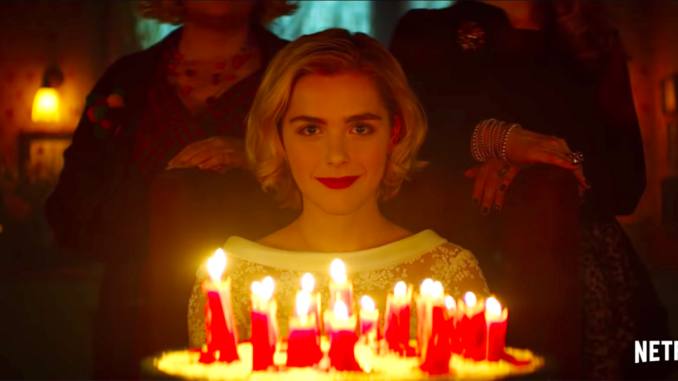
Get ready, witches! The smart and sassy Sabrina Spellman is about to make TV magic…again. But with a ‘Chilling’ makeover and a diverse coven, will we even recognize our favorite teen witch? Salem, I’ve got a feeling we’re not in Westbridge anymore.
Just days after a Buzzfeed post about the twenty-two-year anniversary of Sabrina: The Teenage Witch, Netflix released the trailer for their upcoming show, Chilling Adventures of Sabrina (CAOS). On both posts, comments vary from enthusiasm for a new “dark†teen-witch saga, and nostalgia for the 1996-2003 sitcom, which still resonates decades later.
Although witches live for centuries, thanks to streaming services, mortals of all ages can continue to watch Sabrina, her care-giving aunts, Hilda and Zelda, and their smart-mouthed cat Salem provide a moral lesson in roughly twenty minutes. However, the new adaptation will be unrecognizable to fans of the wholesome TGIF program. CAOS will be a sexy teen-tale filled with creepy imagery and spooky story-lines involving Satanic occult worship. Clearly, Westbridge is absolutely nothing like Greendale.
It seems that CAOS will display more diverse representation than Sabrina. But will switching the tone, from campy to “chilling,†affect the way we view the iconic characters? Will it even garnish the same popularity?
Besides the talking cat, a linen closet that led to the “Other Realm,†giant desserts, evil twins, and a toaster that delivered magical correspondence, at its core, Sabrina was about three independent, strong-willed women and had an undeniable feminist ethos.
Outspoken, witty, and smart, Sabrina Spellman is not your stereotypical cute little blonde. She didn’t spend too much time doing frivolous things like hanging out at the mall, nor were boyfriend’s ever her main focus. A hard-working, straight-A student, who’s good at math, passionate about science, and takes pride in being a good friend, Sabrina was a role-model, appealing to those who ever felt different or strange.
Despite being a witch, she still goes through the same mortal problems we do, including love, loss, and trying to find a place in this vast universe of infinite possibilities. Learning magic is just a metaphor for Sabrina coping with her emotions and inner desires. In most episodes, chaotic hilarity ensues when Sabrina tries magically correcting her problems, until realizing being ethical and selfless is usually the right solution.
Along with its overarching girl power messages, the series metaphorically touches on issues of body image, beauty, classism, bullying, and in its own way, racism and prejudice. Slightly ironic coming from a seven-season long sitcom with an almost entirely white cast. Only three reoccurring Black characters appeared on the show, and their screen-time was short-lived.
At the end of season two, Sabrina briefly dates Dashiell Calzone, a half-mortal witch like herself. The fact that Dashiell is Black is never mentioned. In fact, his character is noted to have more in common with Sabrina than any guy she’s ever dated. When Sabrina chooses her soulmate Harvey instead, promises of “staying friends†wasn’t enough to keep Dashiell around to diversify the cast.
In a memorable fifth season episode, Zelda sets Sabrina up with her dentist’s son, Derek Axelrod, a smart, athletic, attractive full-witch. Things are going great until she learns that Derek’s family are intolerant of mortals and half-mortals alike. After telling insensitive jokes Dr. Axelrod says, “some of my best friends are half-mortals, I just don’t want them living in my neighborhood.†Anyone who utters the phrase, “some of my best friends are…†is attempting to justify their hatred. Sabrina learns the hard way that bigoted ideologies are passed down from parents to children. Even though it was done with an entirely white ensemble, this was one of the only attempts Sabrina made to allude to racism and prejudice in society. The show continuously criticized gender discrimination and emphasized equality and acceptance, but whiteness was still constructed as the norm.
Despite its complete lack of diversity, you’ll be hard-pressed to find someone coming-of-age in the late 1990s who wasn’t under Sabrina’s spell. At its peak, Sabrina had a weekly average viewership of nearly twelve million. Now Netflix is attempting to conjure up some of that same magic.
The trailer for CAOS is to die for. Plus, we already know a few actors of color have been cast, including one set to play a pansexual warlock. Here’s hoping that Sabrina’s new incarnation will feature the same postfeminist qualities that we love – boldness, bravery, and brains – mixed with modern feminist ideologies we’ve come to expect in 2018 — inclusivity of all races, genders, and identities. Are you witches ready?
[embedyt] https://www.youtube.com/watch?v=p3XohOg2ckc[/embedyt]

Leave a Reply